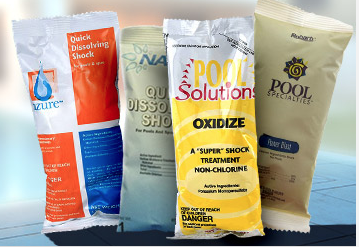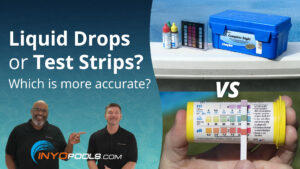Whether your pool is cloudy or full of contaminants, there comes a time when every pool owner needs to shock their pool. However, is there such a thing as too much shock in the pool? Can you “over shock” your pool?
In short, pool shock is simply a concentrated form of chlorine. Shocking your pool, or super chlorination is simply adding enough chlorine to destroy the buildup of chloramines. So, adding too much of it can’t be good… right? Have you ever put too much shock in your pool? If so, what did you do?
And how much is too much?
What Is Shock?
 As pool owners, the things that bind us together are the issues we encounter as we balance and maintain our pools. One of those things is shocking your pool. At some point, even the pools that are the most in tune will need a good shocking.
As pool owners, the things that bind us together are the issues we encounter as we balance and maintain our pools. One of those things is shocking your pool. At some point, even the pools that are the most in tune will need a good shocking.
The point of shocking your pool is to get rid of all of the dirt, chloramines, and bacteria in your pool by introducing a large amount of concentrated chlorine to your water at once.
When shocking your pool, you are adding so much Free Chlorine that it breaks the molecular bonds of the chloramines. You want to reach this breaking point every time you shock your pool to prevent algae from building up. Failing to hit the breaking point can potentially cause more chloramines.
There are several different kinds of pool shock. They have different chemical compositions and purposes. For more information, you can review our article on the differences between pool shocks.
But, how does one add too much shock?
Before Shocking Your Pool
 Normally, shocking your pool can temporarily cloud your pool. If you do not give your pool water enough time to breathe between treatments, you are compiling all of the cloudiness at once. At this rate, you won’t see any improvements.
Normally, shocking your pool can temporarily cloud your pool. If you do not give your pool water enough time to breathe between treatments, you are compiling all of the cloudiness at once. At this rate, you won’t see any improvements.
Still, before adding shock or chlorine, we recommend that you test your pool water first. If you are responsible for maintaining your own pool it’s a good idea to keep a good test kit on hand. This helps you to avoid having to run up to your local pool store for a test. First, test your Free Chlorine and Total Chlorine levels to determine how much Combined Chlorine you have. Your Combined Chlorine tells you how much shock you need to add.
Although most manufacturers include instructions for shock treatment, charts, and/or steps to help you calculate how much shock you need, if you still prefer to calculate it yourself, we have included the steps below.
How Much Shock Do I Need?
- To find your Combined Chlorine (CC), subtract your Free Chlorine (FC) from your Total Chlorine (TC).
- Multiply your CC by 10.
- Subtract your FC from that sum.
- Using the information on the package, determine the amount of shock that produces 1 ppm chemical change in 10,000 gallons of water
- Divide your pool volume by 10,000. Note this number.
- Next, multiply the chemical change ( step 4) by the divided pool volume (step 5) and the CC/FC difference (step 3).
- Convert the answer into pounds by dividing it by 16. This answer tells you how much pool shock you need to add.
A good rule to remember is to use one bag of shock (1 gallon of liquid chlorine) per 10,000 gallons.
Too Much Shock?
Now, let’s assume you’re like me and suck at math. There might come a time when you “over-shock” your pool. Adding more shock and more shock to your pool won’t speed up the process. In reality, it does the exact opposite.
Another mistake that goes hand in hand is measuring your chlorine levels too soon after you have shocked the pool. The high chlorine levels actually “bleach” the test strip, giving you a false reading. In fact, most manufacturers do not design their test strips to withstand extremely high levels of chlorine. If you have just shocked your pool and you measure your chlorine levels, it may appear like you have no chlorine at all. As a result, pool owners continue to add more shock. It’s a good idea to give your pool time to oxidize. So, wait a few days before testing your water.
If you put too much shock in the pool, simply wait it out. If you have a cover on your pool, take it off. The more sun that hits your water, the faster it will dissipate. Technically, if your free chlorine levels are holding up swimming UP TO your shock level, depending on your CYA, is safe. Keep in mind, no one should swim in a cloudy pool, even if your free chlorine levels are holding. If the water clarity prevents you from seeing the bottom of the pool, we recommend you do not return to the pool.
In short, test your water a few days after you have shocked your pool to determine exactly how high your free chlorine levels are. Don’t forget to review the instructions on the back of your shock. Most companies provide the levels that they recommend to be safe for swimmers to return to the pool.
Feel free to check out our other blog post How Long After I Shock My Pool Can I Swim?












Leave a Reply